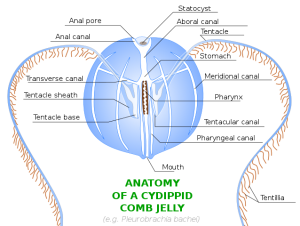Ctenophora
 Kingdom: Animalia
Kingdom: Animalia
Subkingdom: Eumetazoa
Phylum: Ctenophora
Ctenophora is a phylum of exclusively marine invertebrates. Ctenophora means “comb-bearing”. They are commonly known as comb jellies or sea walnuts. The distinguishing feature of the phylum is the presence of comb plates with cilia that are used for locomotion.
- They are free-living marine organisms.
- They are diploblastic, i.e. possess two embryonic layers, ectoderm and endoderm. Mesoglea is present between the ectoderm and endoderm, which is not well differentiated.
- They are acoelomates, i.e. do not have a body cavity.
- Ctenophores are radially symmetrical.
- They have a tissue level of body organisation.
- Ciliated comb plates are the locomotory organs. It has a group of cilia that helps in locomotion. They possess mostly eight rows of comb plates. They are the largest single animals using cilia for locomotion. Cilia are arranged in comb-like bands known as “ctenes”.
- The size ranges from 1 mm to 1.5 m in size.
- Most ctenophores have colloblasts to capture prey. Colloblasts are like cnidoblasts in cnidarians. They are present on tentacles and are discharged to capture prey.
- Colloblasts consist of collocytes, which have a coiled spiral filament. Colloblast has adhesive, which sticks to the prey, unlike cnidoblasts that have stinging capsules.
- Sensory cells are present in the outer epidermis. They secrete mucus and provide protection.
- Interstitial cells are also present in the outer epidermis. They can transform into other cell types.
- The nerve net is present in the inner epidermis. It also contains myoepithelial cells, which work like muscles.
- The internal cavity is formed by the mouth, pharynx and internal canals. Cilia is present in the mouth and pharynx. The cavity is lined by the gastrodermis internally.
- The gastrodermis contains nutritive cells, germ cells and photocytes, which store food, produce egg or sperm and are responsible for the bioluminescence, respectively. Ciliated cells in the gastrodermis are responsible for water circulation in the canals and remove wastes.
- Digestion occurs extracellularly as well as intracellularly.
- They do not possess a brain or the nervous system. They have a nerve net, which is found around the mouth region and more concentrated in the comb rows and tentacles.
- It contains a statocyst in the aboral region, situated opposite the mouth. It has a sensory function. It is a balancing organ and helps the organism in swimming.
- They are bisexual. Sexes are not separate.
- Ctenophores reproduce sexually. Fertilisation occurs outside the body. Development is indirect.
- Some produce sperms and eggs at the same time and some at different times.
- Platyctenids also reproduce by fragmentation. They show internal fertilisation and eggs remain in the brood chambers until hatched.
- Most species show regeneration of damaged tissues.
- They show bioluminescence, i.e. emit light.
- They show bioluminescence, i.e. emit light.
- Ctenophores are soft-bodied, free-swimming marine animals having biradial symmetry and comb-like ciliary plates for movement. They are devoid of nematocytes. They are also known as sea walnuts or comb jellies.
